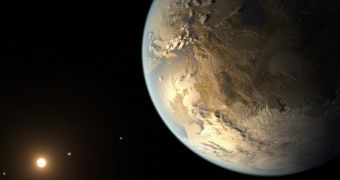Astronomers using the NASA Kepler planet-hunting telescope were recently able to identify the first Earth-like planet that lies within the habitable zone of its parent star. Previously, worlds found in similar positions have been several times more massive than our planet, but the new object is the first that might actually support liquid water on its surface, as well as life as we have come to know it.
The extrasolar planet is called Kepler-16f and is one of the five exoplanets orbiting an M-spectral type red dwarf star located around 500 light-years away, in the constellation Cygnus (The Swan). This finding is extremely important because M dwarfs make up around 70 percent of the roughly 100 billion stars estimated to exist in the Milky Way.
This particular star, called Kepler-16, is two times smaller and two times less massive than the Sun. This means that its habitable zone is located a lot closer to its surface. This region exists around every star and represents the distance boundaries between which temperature levels are just right to support the presence of liquid water on the surface of a planet or asteroid.
In our solar system, Earth lies at the very center of the Sun's habitable zone, while Venus and Mars skirt its inner and outer boundaries, respectively. Some astronomers believe that our parent star, a G-type yellow dwarf, may be part of a less significant population of stars that have planets. “M dwarfs are the most numerous stars,” says expert Elisa Quintana.
“The first signs of other life in the galaxy may well come from planets orbiting an M dwarf,” adds the investigator, who holds an appointment as a research scientist with the SETI Institute at the NASA Ames Research Center (ARC) in Moffett Field, California. She is also the lead author of a new paper detailing the Earth-like exoplanet, published in the April 17 issue of the top journal Science.
“We know of just one planet where life exists – Earth. When we search for life outside our solar system we focus on finding planets with characteristics that mimic that of Earth. Finding a habitable zone planet comparable to Earth in size is a major step forward,” Quintana adds. Kepler-16f orbits its parent star a lot faster than Earth does the Sun.
While a year on our planet lasts for roughly 365 days, a year on Kepler-16f lasts for just 130 days. Scientists estimate that the exoplanet receives only a third of the total amount of energy the Earth does from the Sun. One thing worth mentioning here is that the rocky nature of the alien world has not yet been established. The size of the planet is known, but its actual mass and composition are not.
“The discovery of Kepler-186f is a significant step toward finding worlds like our planet Earth. Future NASA missions, like the Transiting Exoplanet Survey Satellite and the James Webb Space Telescope, will discover the nearest rocky exoplanets and determine their composition and atmospheric conditions, continuing humankind's quest to find truly Earth-like worlds,” says scientist Paul Hertz.
The expert is the director of the Astrophysics Division at NASA Headquarters in Washington, DC. He adds that the new study confirms Kepler-16f lies at the outermost boundary of Kepler-16's habitable zone. Exoplanets are named by taking the designation of their parent star and adding a letter to it. For example, the star Kepler-16 is orbited by Kepler-16b (the first exoplanet from that star), Kepler-16c, and so on.
According to Kepler measurements, the other four exoplanets in this star system revolve around their parent star every 4, 7, 13, and 22 days. This means that Kepler-16f is the most distant exoplanet from the M dwarf in this star system. But “being in the habitable zone does not mean we know this planet is habitable,” explains research scientist Thomas Barclay.
“The temperature on the planet is strongly dependent on what kind of atmosphere the planet has. Kepler-186f can be thought of as an Earth-cousin rather than an Earth-twin. It has many properties that resemble Earth,” adds Barclay, who holds an appointment with the Bay Area Environmental Research Institute at ARC. He was also a coauthor of the new Science paper.
Even though an identical Earth twin remains elusive, this investigation demonstrates that Kepler can indeed discover Earth-sized planets inside the habitable zone of other stars. The telescope will continue to monitor more than 150,000 stars in the Milky Way for any signs of a potentially-habitable world.

 14 DAY TRIAL //
14 DAY TRIAL //